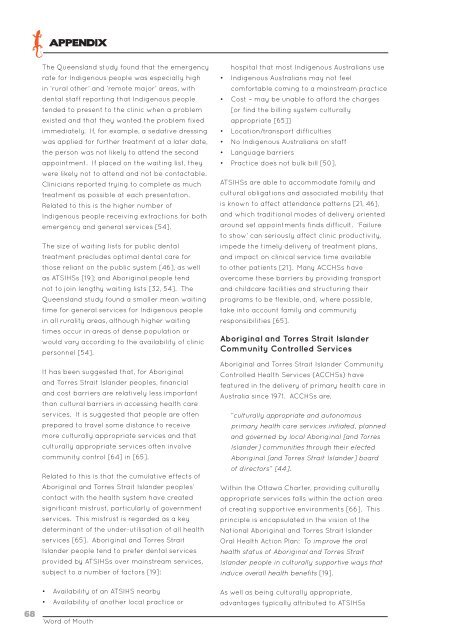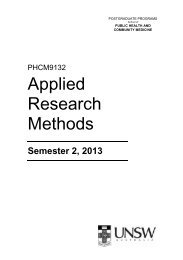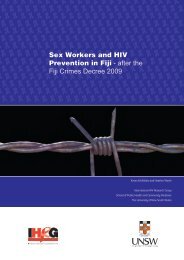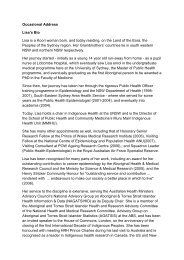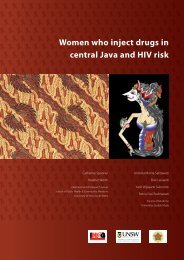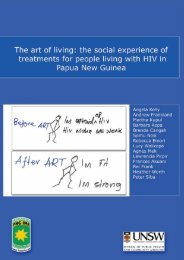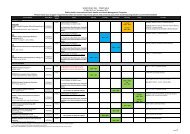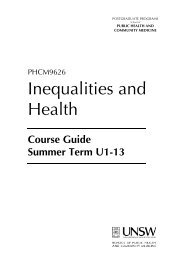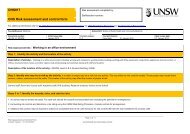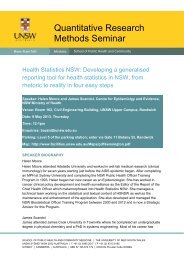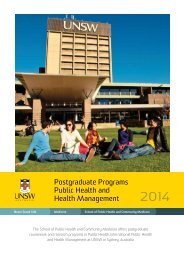Word of Mouth - School of Public Health and Community Medicine ...
Word of Mouth - School of Public Health and Community Medicine ...
Word of Mouth - School of Public Health and Community Medicine ...
- No tags were found...
You also want an ePaper? Increase the reach of your titles
YUMPU automatically turns print PDFs into web optimized ePapers that Google loves.
APPENDIXThe Queensl<strong>and</strong> study found that the emergencyrate for Indigenous people was especially highin ‘rural other’ <strong>and</strong> ‘remote major’ areas, withdental staff reporting that Indigenous peopletended to present to the clinic when a problemexisted <strong>and</strong> that they wanted the problem fixedimmediately. If, for example, a sedative dressingwas applied for further treatment at a later date,the person was not likely to attend the secondappointment. If placed on the waiting list, theywere likely not to attend <strong>and</strong> not be contactable.Clinicians reported trying to complete as muchtreatment as possible at each presentation.Related to this is the higher number <strong>of</strong>Indigenous people receiving extractions for bothemergency <strong>and</strong> general services [54].The size <strong>of</strong> waiting lists for public dentaltreatment precludes optimal dental care forthose reliant on the public system [46], as wellas ATSIHSs [19]; <strong>and</strong> Aboriginal people tendnot to join lengthy waiting lists [32, 54]. TheQueensl<strong>and</strong> study found a smaller mean waitingtime for general services for Indigenous peoplein all rurality areas, although higher waitingtimes occur in areas <strong>of</strong> dense population orwould vary according to the availability <strong>of</strong> clinicpersonnel [54].It has been suggested that, for Aboriginal<strong>and</strong> Torres Strait Isl<strong>and</strong>er peoples, financial<strong>and</strong> cost barriers are relatively less importantthan cultural barriers in accessing health careservices. It is suggested that people are <strong>of</strong>tenprepared to travel some distance to receivemore culturally appropriate services <strong>and</strong> thatculturally appropriate services <strong>of</strong>ten involvecommunity control [64] in [65].Related to this is that the cumulative effects <strong>of</strong>Aboriginal <strong>and</strong> Torres Strait Isl<strong>and</strong>er peoples’contact with the health system have createdsignificant mistrust, particularly <strong>of</strong> governmentservices. This mistrust is regarded as a keydeterminant <strong>of</strong> the under-utilisation <strong>of</strong> all healthservices [65]. Aboriginal <strong>and</strong> Torres StraitIsl<strong>and</strong>er people tend to prefer dental servicesprovided by ATSIHSs over mainstream services,subject to a number <strong>of</strong> factors [19]:hospital that most Indigenous Australians use• Indigenous Australians may not feelcomfortable coming to a mainstream practice• Cost – may be unable to afford the charges[or find the billing system culturallyappropriate [65]]• Location/transport difficulties• No Indigenous Australians on staff• Language barriers• Practice does not bulk bill [50].ATSIHSs are able to accommodate family <strong>and</strong>cultural obligations <strong>and</strong> associated mobility thatis known to affect attendance patterns [21, 46],<strong>and</strong> which traditional modes <strong>of</strong> delivery orientedaround set appointments finds difficult. ‘Failureto show’ can seriously affect clinic productivity,impede the timely delivery <strong>of</strong> treatment plans,<strong>and</strong> impact on clinical service time availableto other patients [21]. Many ACCHSs haveovercome these barriers by providing transport<strong>and</strong> childcare facilities <strong>and</strong> structuring theirprograms to be flexible, <strong>and</strong>, where possible,take into account family <strong>and</strong> communityresponsibilities [65].Aboriginal <strong>and</strong> Torres Strait Isl<strong>and</strong>er<strong>Community</strong> Controlled ServicesAboriginal <strong>and</strong> Torres Strait Isl<strong>and</strong>er <strong>Community</strong>Controlled <strong>Health</strong> Services (ACCHSs) havefeatured in the delivery <strong>of</strong> primary health care inAustralia since 1971. ACCHSs are,“culturally appropriate <strong>and</strong> autonomousprimary health care services initiated, planned<strong>and</strong> governed by local Aboriginal [<strong>and</strong> TorresIsl<strong>and</strong>er] communities through their electedAboriginal [<strong>and</strong> Torres Strait Isl<strong>and</strong>er] board<strong>of</strong> directors” [44].Within the Ottawa Charter, providing culturallyappropriate services falls within the action area<strong>of</strong> creating supportive environments [66]. Thisprinciple is encapsulated in the vision <strong>of</strong> theNational Aboriginal <strong>and</strong> Torres Strait Isl<strong>and</strong>erOral <strong>Health</strong> Action Plan: To improve the oralhealth status <strong>of</strong> Aboriginal <strong>and</strong> Torres StraitIsl<strong>and</strong>er people in culturally supportive ways thatinduce overall health benefits [19].68• Availability <strong>of</strong> an ATSIHS nearby• Availability <strong>of</strong> another local practice or<strong>Word</strong> <strong>of</strong> <strong>Mouth</strong>As well as being culturally appropriate,advantages typically attributed to ATSIHSs


